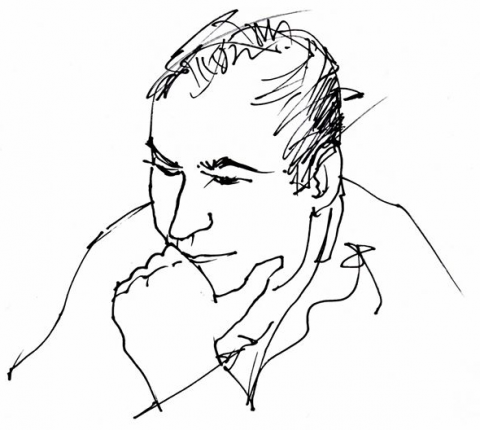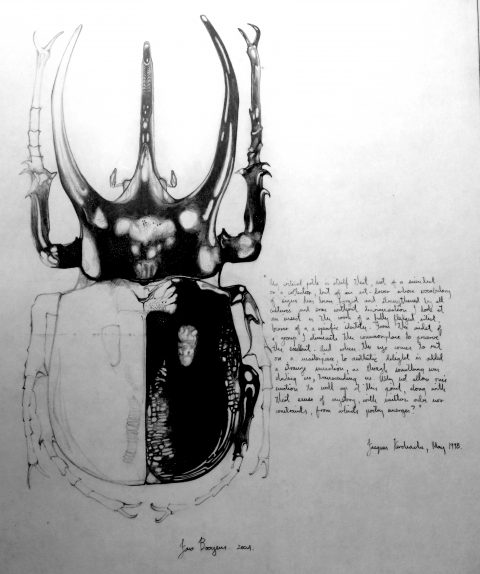Arch SA
The SAIA Award Winners
Posthumous Gold Medal − Jeremy Robert Rose
Jeremy Robert Rose co-founded Mashabane Rose Associates (MRA) with Phill Mashabane in 1995. Barely 20 years later, on 20 December 2015, Rose tragically passed away at age 52, leaving a palpable void not only in the practice, but also in the broader industry. Despite being cut short, Rose’s prolific career left an impressive legacy of design excellence and an undeniably memorable mark on contemporary South African architecture.
After graduating from the University of the Witwatersrand in 1988, Rose went into exile in Botswana where he practised as a young architect for several years. Upon his return to a new democratic South Africa in 1995, it didn’t take long for the newly- formed MRA to establish itself through its passionate and determined commitment to making a meaningful contribution to post-apartheid South Africa.
Challenging the odds of a start-up practice, Rose and Mashabane set about generating work in the heritage sector; a genre of particular interest to them both. Their self-commissioned Soweto Heritage Trail opened the door to an impressive portfolio of award-winning projects that expanded an inclusive cultural narrative of South Africa, including the Apartheid Museum (SAIA Award of Excellence), the Hector Pieterson Memorial and Museum, the Mandela House Museum, the Liliesleaf museum (SAIA Award of Merit) and HAPO Freedom Park (SAIA Award of Excellence).
As principal designer, Rose was the driving force behind the practice’s architectural expression, the impact of which was evident in their regular placement on the ‘finalists’ roll’ for architectural design competitions, locally and internationally. Their exceptional presentations raised the bar in this arena for the profession. Significant competition victories included their projects for the Robben Island Millennium Structure, the Oprah Winfrey Leadership Academy for Girls, the University of Johannesburg Arts Centre, Liliesleaf, the Golden Gate Dino Park Visitor Centre, Tshwane Bus Rapid Transport stations and Anglo-American Reinvention. These projects, which cover a broad range of briefs, conceptual explorations and architectural typologies, demonstrate that Rose’s passion for design was committed, insatiable and infectious.
Yet behind the image of a fiercely determined design competitor, Rose was a caring, gentle man who enjoyed nurturing the talents of young architects. In the same way that he never turned down a competition, he never turned down the invitation to participate as a guest lecturer, reviewer and examiner at national tertiary institutions, to which he was frequently invited. And within the practice, his tendency to mentor was folded effortlessly into the necessity for relevant project output. The time he spent at junior architects’ desks, sketching or detailing, was infinitely more meaningful than an employer ‘checking on progress’; it was a deeply personal, profound conversation about design and life merged seamlessly into one. His inventive entrepreneurial spirit ensured that design rigour was applied to all aspects of the profession − even the brief − and these skills were generously shared in studio conversation. The talented architect was an equally gifted and generous architectural teacher.
As the 2014 Sophia Gray laureates, the MRA partners rose to the occasion, despite the challenging advancement of Rose’s illness. The work on display at Bloemfontein’s Oliewenhuis Art Museum ranged from the well-known ‘nation-building’ projects to houses, galleries, schools and even a sundial. This immense body of work displayed was a profound testimony to a life’s passion for all things South African: its landscape, its people, its history and its future.
It is for this exceptional, passionate, life-long contribution to the profession that the SAIA Gold Medal for Architecture is conferred posthumously by the SAIA board on Jeremy Robert Rose – may his architectural legacy continue to inspire us.
Gold Medal − Mira Fassler Kamstra
Mira Fassler Kamstra graduated from the University of the Witwatersrand in 1961. After starting as one of five women in the first year, Kamstra was one of three to graduate. She grew up in an environment permeated with design and architecture. Her father, John Fassler, was a professor and later the head of architecture at Wits, and an associate of Bernard Cooke and Rex Martienssen.
In her early years of practice (1962–1970), Kamstra worked for a series of leading architects: Andre Hoffe, Hans Hallen, Willie Meyer and John Fassler. She also married and had three children during this period, combining the rigours of practice with the challenges of bringing up small children.
In 1969, Kamstra worked with John Fassler on the Central Campus Master Plan at the University of the Witwatersrand. On the death of her father, she inherited his practice in 1971 and was forced to step up to the challenge of completing Senate House at the University.
In the 1970s, Kamstra practised independently and in association with other architects, before going into partnership with Marcus Holmes, as Fassler Kamstra + Holmes Architects, in 1978. Some of Kamstra’s best-known works date from this period, most notably her work at Saheti − the primary and nursery schools − and House de la Harpe, for which she received Awards of Merit in 1977 and 1981. Over the course of her career she has received a total of six SAIA Awards of Merit as well as three Regional Awards.
Her body of work is extensive and wide-ranging; from individual works and adaptive re-use to large-scale civic proposals. Every project is approached with a high level of attention to detail and design, and she has developed a deep knowledge of architectural conservation and landscape design. Her work in this regard was recognised in 2007, when she was awarded a Gold Medal for House LP Collet in Inanda by the SA Landscapers Institute.
Kamstra has also served the profession during her career in a variety of roles, from membership of various committees of the former Transvaal Institute of Architects to membership of SACAP validation panels, and external examiner at several schools of architecture. She was elected President of the Transvaal Institute of Architects, serving in that capacity from 1993−1996, when the institute was reconstituted.
Kamstra’s work has been published and exhibited extensively and she has been a sought-after speaker. So it was no accident that she was the first presenter of the Sophia Gray Memorial Lecture and Exhibition in 1989. She has generously contributed to the profession by ensuring that architectural heritage and institutional memory are sustained, not only by mentoring young professionals, but by archiving her and her father’s drawing and book collections.
It is for this enduring legacy − her contribution to the discourse of architecture in South Africa and an oeuvre of architectural work of sustained excellence spanning over 50 years – that the Gold Medal for Architecture is awarded by the SAIA Board to Mira Fassler Kamstra, SAIA’s own grande dame of architecture.
SAIA Medal of Distinction − Sindile Alfred Ngonyama
From humble beginnings as a child in Middleburg in the Karoo, Sindile Ngonyama’s family was forcibly moved to a township in Whittlesea, outside Queenstown in the Eastern Cape. This is where he completed most of his schooling and, after matriculating, Ngonyama worked in a government drawing office in the Ciskei for a number of years.
Having always had an aptitude for art and hand-crafts, he was granted a bursary to study architecture at the University of Cape Town. Ngonyama graduated from UCT in 1986, and worked both in the private and government sectors before opening a branch office for Plan Architects in East London in 1993.
Ngonyama is a founding director of Ngonyama Okpanum and Associates (1997), where he continues to practise, with offices in East London, Port Elizabeth, Cape Town and Johannesburg.
He is best known to the SAIA board, its members and the wider architectural fraternity as their immediate past president, having served two consecutive terms of office (2012–2016) and, during this period, having steered the institute through the UIA 2014 World Congress and the implementation of the new SAIA Constitution.
Ngonyama has also been instrumental in establishing the Mdantsane Community Development Trust, and has run the Emerging Contractor Development Programme of the Department of Public Works. He has served as local chairman and later national deputy president of SABTACO (South African Black Technical and Allied Careers Organisation).
Ngonyama’s service to architecture in South Africa reflects the natural leadership qualities of his personality and temperament. His steady growth in stature, as a statesmen, and voice in the profession has gained the respect of all, and his loyal service to the betterment of the practice of architecture and the transformation of our environment deserves recognition at the highest level. His four years at the helm were well beyond the call of duty and his agreement to a second term of office is a credit to his selfless dedication to SAIA.
It is with gratitude and immense admiration that the Medal of Distinction is conferred by the SAIA board on our own architectural statesman, Sindile Alfred Ngonyama.
Architectural Writers and Critics Award − Professor Iain Low
Iain Low is known to fellow SAIA members primarily as the editor of the annual Digest of South African Architecture. Endorsed by SAIA, it has a mandate to review and document the annual production of SAIA members over each year and present the work as a detailed record and archive for the benefit of the greater architectural community. It is appreciated by SAIA members, used by students and purchased by the public. It provides an excellent opportunity for architects to present themselves and engage with society at large.
Professor Low has served on the editorial board, and later as editor of the Digest for South African Architecture, since the 2003/4 edition (Volume 7). During that time, he raised the standards and ensured that these were implemented without compromise. In addition to his full-time position at UCT, Professor Low has dedicated a large portion of his time to ensuring that the Digest for South African Architecture remains one of the leading titles in the profession. This has resulted in it becoming one of the top titles in publisher Picasso Headline’s stable, and winning PICA awards. Professor Low’s thought-provoking editorials have also influenced the architectural debate amongst architects, academics and students alike.
Professor Low has also been involved in a number of initiatives for SAIA:
- He has been a member of the editorial board and editor of the Digest of African Architecture published in 2008 to accompany SAIA’s bid to host the UIA congress in Durban in 2014.
- He has been a member of the editorial collective of the first few editions of the SAIA Awards book.
- He has sat on a number of committees to advise on the structures for other SAIA publications and publication-related initiatives. These include Arch SA: Journal of the South African Institute of Architects, and a number of SAIA publications.
Research and writing is an integral part of Professor Low’s everyday life as an academic. He has stated that “the projection of ideas into the public domain is both a means of engaging and of measuring one’s participation in a community”. His area of research has always included space and transformation, the contemporary [post-apartheid] city, and the sustainability and transition of South African cities for the future.
Professor Low is published in many local and international architecture and urban design journals, and is regularly invited to deliver papers and participate at various international and local conferences and examinations.
Professor Low is a fiercely independent and critical thinker, uncompromising, outspoken and fearless in criticism. He has a strong work ethic and is a dedicated teacher who sets high standards for the education of architects. He is a straight talker, has been fondly described as ‘prickly’, but always generously shares his wicked sense of humour.
The Architectural Writers and Critics Award is conferred by the board of SAIA on Professor Iain Low. It is well-deserved and overdue.






 Sign-up and receive the Business Media MAGS newsletter OR SA Mining newsletter straight to your inbox.
Sign-up and receive the Business Media MAGS newsletter OR SA Mining newsletter straight to your inbox.